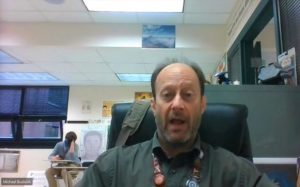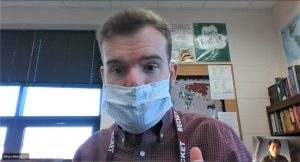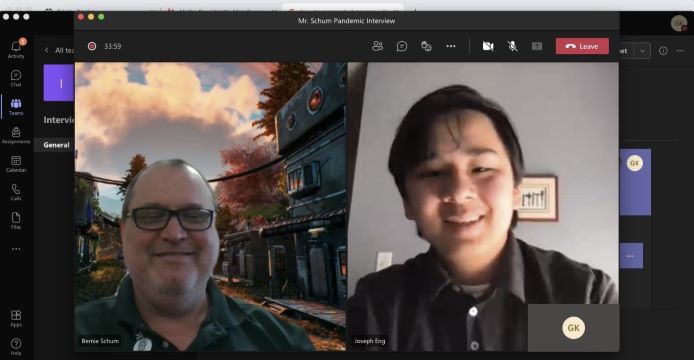Overcoming the Obstacles of Teaching in a COVID Year
Trinity teacher Mr. Bernie Schum spoke with reporter Joseph Eng about the challenges of teaching in a COVID year.
May 17, 2021
“This, without question of a doubt, has been the roughest year of teaching since my first year 24 years ago. If we have to do this again next year, I’m done; I will retire!”
As expressed by Trinity teacher Mr. Michael Budniak, he and other teachers have found this school year to be an extreme challenge due to COVID-19, not because they were scared of the virus, but because online learning affected the curriculum they taught and their relationships with their students.
Due to fewer class days and the complications that went along with a hybrid schedule of NTI and in-person, most teachers had to cut down on how much material they taught.
Budniak, a biology teacher who has taught at Trinity since 1997, said, “Probably 15 to 20 percent of the curriculum has been affected or removed. The biggest things that have been affected are laboratories and any type of group-based interactions. I know how much time and information I would normally cover that I have had to throw out the airlock.”
Teachers have had an enormous challenge deciding what material to cut. Mr. Bernie Schum, a theology teacher at Trinity since 2004, said, “I have really wrestled with what assignments are essential and trying to come up with ways I can still accommodate engagement as best as possible.”

This has been an especially difficult time for teachers who have activity-based classes. Having taught art at Trinity since 2014, Mr. Shayne Hull, has had a tough time planning projects and assignments for the in-person and online students.
One difficulty was supplying the materials to students and planning what the online students would do when the in-person students were working on projects. He said, “There are just a lot of different things that have gone on with art courses during the hybrid, NTI schedule. It has been a challenge, but we have been making the best of it.”
Working through this COVID year has not all been bad. Cutting down on some class material has allowed some teachers to develop better assignments.
Second-year Trinity history teacher Mr. Ethan Morris said, “The workload is reduced, so this year especially I have been able to give more complex tests and know that students will have the time of day to actually read and answer them, but also give some thought.”
Trinity teachers have always had the mission to keep their students engaged and teach them effectively. A hybrid schedule of in-person and online school has required balancing how much to require of students.
Budniak said his most important goal has been “trying to maintain a degree of true academic rigor for Advanced Program classes and maintain the standard I set for students that are supposed to be functioning at the highest level possible. Maintaining those academic standards when somebody is exclusively online is challenging.”

Online attendance can sometimes lead to what Budniak calls “the path of least resistance.”
Morris said, “It is difficult to have really good, meaningful dialogue when half of the kids are in the classroom, and the other half is at home. What tends to happen is that people at home aren’t able to engage as readily. Even the best of students struggle with discussing online, and for a class like mine, where discussing is one of the key ways we process things, I’ve had to make some adjustments.”
Adjustments have meant rethinking expectations. Hull said he has not lowered his standards but understands the limitations of student projects.
Online learning and wearing masks have also created some obstacles to student and teacher bonding.
Every teacher at the beginning of the school year sets out to learn every student’s name and face. Some teachers get that down in the first week, while others can take a month; however, COVID-19 has made this simple goal nearly impossible.
Hull, one of those teachers who gets the names in the first week, said, “Frankly, the guys that are online only, there have been a few of them that after six weeks of the course came in for supplies, and when I saw them, I didn’t recognize them.”
COVID-19 forced a number of students to stay at home, and as a result, their avatars took on their names.
Morris found the same problem and said, “If you have been completely online, I don’t really even know who you are. If I don’t see your face or hear your voice that much, it is hard to form a connection.”
Well into the year, Budniak said, “I am still learning who people are. I still have people in my class I don’t even know who they are.”
There is no doubt this school year has been far from normal, which united teachers and students somehow.
Schum found that his relationship with students grew differently. “In a weird way, through the burden, we have connected better. Students don’t have all the typical distractions a normal year would have. I know it isn’t easy for students, either. This has not been easy on any segment of the population. That has brought people together in some regard.”
Extraordinary circumstances call for extraordinary responses. Teaching and learning took on a new meaning this year, and teachers have grown and learned new lessons through this hardship. Almost every teacher cannot wait to get back to all in-person classes, and one thing they will not do is take it for granted.
As Schum said, “The normalcy of just a familiar face is a big deal, and we took that for granted.”



